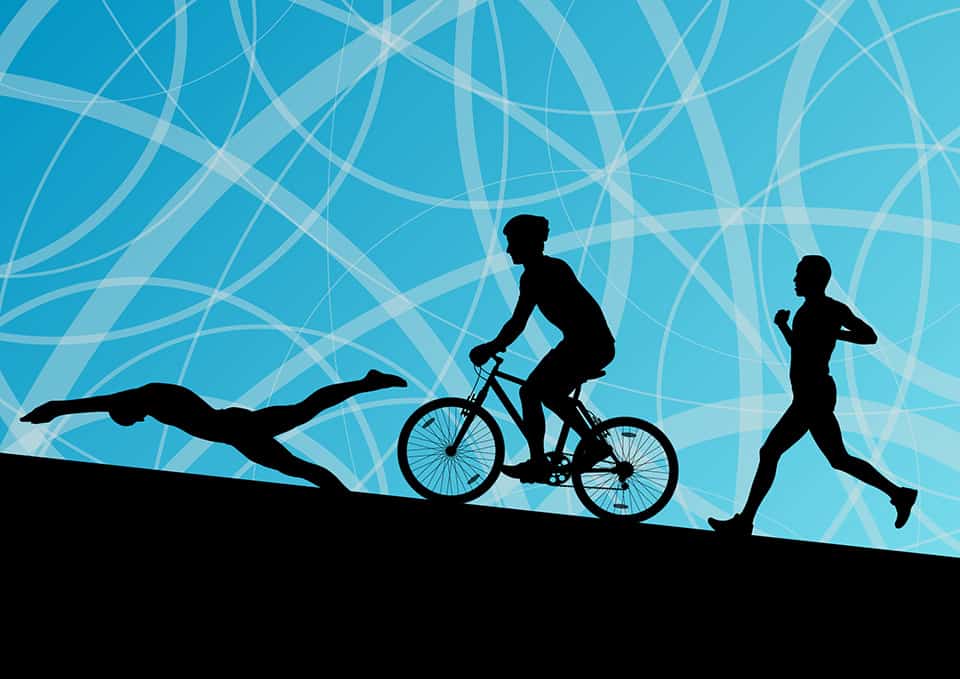
Cycling, Does It Burn More Than Running Or Swimming?
Cycling is a great weight-loss activity; it burns a lot of calories, it’s easier on your joints than running, and it has a whole host of health benefits.
But how many calories does it actually burn?
Answering that question is rather difficult, but we’ll dive in and take a look.
We’ll start by looking at why calories burned is a difficult thing to measure, then discuss how many calories cycling burns, compare it to other sports, and offer some ideas to maximize the number of calories you burn on your bike.
At the end, we’ll discuss some important concepts to keep in mind for weight loss.
That’s a lot to cover, so let’s get started!
Why Worry About Calories at All?
Before we get into the details of how many calories cycling burns, let’s talk about why you might be interested in calorie burn at all.

While you could have a number of reasons, it’s likely that you’re curious about calories because you want to lose weight. The most basic tenet of weight loss is that if you eat fewer calories than you burn, you’ll lose weight.
It’s as simple as that.
But figuring out how many calories you eat and how many you burn isn’t always easy. And maximizing the number that you burn through exercise takes some effort.
Still, it all comes down to calories.
If you have fewer coming in than going out, you’ll lose weight. We’ll talk about how to calculate the number of calories that you burn later on. But keep this basic idea in mind throughout your weight-loss journey, and you’ll be successful.
How to Calculate Calories Burned
If you think of calories as simply a nutritive measurement, you’re going to have to have to make an adjustment for this explanation to make sense.
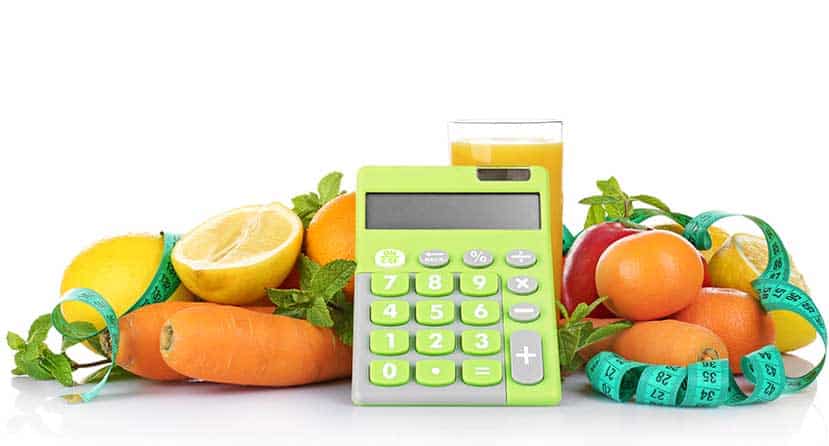
A calorie (technically capitalized, as “Calorie,” and more accurately called a kilocalorie) is actually a measurement of energy. The number of calories in food is equal to the energy content of that food.
Carbohydrates, fat, and protein all provide the body different amounts of energy—if you know how much of each a food has, you know the caloric content.
When you’re talking about calories burned, you’re looking at the opposite: it’s the amount of energy that your body expends. You need fuel to expend that energy, and your body uses sugar in your bloodstream or stored fat to create that energy.
As I mentioned previously, if you burn more calories than you consume, you’ll lose weight. (To be fair, there are other factors involved, but this is the most basic calculation.)
Once you start seeing calories in this way, you’ll start thinking about food differently. A sandwich might be equivalent to an hour-long workout, and a morning coffee might require a mile walk to make up for. It all depends on your diet and exercise.
But how do we know how many calories an activity burns?
We talked about how scientists figure out how many calories are in a given food, but what about exercise?
One way is to have a person exercise and closely monitor the temperature of the room they’re in. When they expend energy, they necessarily raise the temperature, and that can be used to determine how many calories have been used.
A more common way is to monitor the amount of oxygen a person takes in and the amount of carbon dioxide they breathe out. Using complex formulas, scientists can use this information to figure out how many calories they’ve burned.
Over many years, and with many research studies, they’ve come up with some pretty reliable figures about how many calories a type of exercise—including cycling—burns.
By using a few pieces of information about you, like your height and weight, and possibly a few others, like your body composition or heart rate, algorithms can come up with a reasonably accurate number for calorie burn.
How Accurate Are Calorie Burn Calculators?
Okay, so we know how scientists figure out how many calories you burn. But do online calculators or fitness devices translate that information accurately?
Unfortunately, not really.
Stanford University looked at seven popular fitness devices to see how well they estimated calorie burn during exercise, and the most accurate device was off by 27%. If that device told you that you burned 1000 calories, you might have only burned 730. That’s a notable difference. And that was the most accurate device.
Other methods, like the calorie burn estimators built into treadmills and elliptical trainers, aren’t much better. SHAPE reports that elliptical over-estimate calorie burn by up to 42%. If you use that to plan your diet, you’re going to be over-eating.
Online calculators face similar problems.
So what are you supposed to do?
The best thing you can do when calculating your energy expenditure is to treat any number as a rough estimate. Unless you’re in an exercise lab where a trained scientist tells you how many calories you’re burning, you’re going to have to settle for a relatively inaccurate figure.
There’s no way around it. Even high-end heart rate monitors can still only give you rough estimates. To make sure you get consistent counts, though, you should use the same method each time. If you decide to use your fitness device, use that every time.
If you use an online calculator, use the same one. At the very least, this gives you the ability to compare your calorie counts over time.
Factors That Influence How Many Calories You Burn
Calorie burn calculators aren’t very accurate. And we don’t always know how inaccurate they are, which makes counting calories difficult.

But we do know quite a few things that influence how many calories you burn, and you can use this information to your advantage.
Here are a few to keep in mind:
Type of Exercise
Of course, the type of exercise you’re doing affects how many calories you’re burning.
We’re focusing on cycling here, but it’s good to keep this in mind when you’re comparing cycling to other types of activity. Activities that involve large muscle groups or vigorous activity—like running and cycling—burn the most calories.
Less intense activities, like walking, burn fewer.
Some activities that feel intense, like weightlifting, might not burn many calories at all (that’s not to say that added muscle mass won’t increase the number of calories your burn).
If the activity is weight-bearing (i.e., you’re supporting your weight while you exercise), it’ll burn more calories, too. That’s why running burns more than cycling, and one of the reasons why swimming doesn’t burn as many as either.
Exercise Duration and Intensity
First, duration. If you exercise longer, you’re going to burn more calories. That’s pretty self-evident.
However, you need to take your exercise intensity into account, too. The harder you’re working, the more calories you’ll burn.
According to the CDC, vigorous-intensity aerobic activity (like jogging) is twice as effective as moderate-intensity aerobic activity (like brisk walking). While they don’t give specific calorie counts, the point is clear: working harder burns more calories. Many people get caught up in the idea of “fat-burning zones” and using their heart rate to tailor their exercise to burn more fat.
Some people have success with this, but the truth is that the harder you work, the more calories you burn. That’s what it comes down to.
Body Weight and Composition
The more you weigh, the more work your muscles have to do to complete the same motions.
Different activities will have different changes in calorie count due to body weight. Running, for example, will burn a lot more calories taking more weight into account, because the entire body weight is supported on each step.
In cycling, body weight is less of a factor, because you don’t need to support your weight—the bike does most of that. Body composition also makes a difference; two people with the same weight might not burn the same amount of calories if one has more muscle.
Because muscle is working during activity, it’s burning calories. Fat isn’t working, and doesn’t expend any energy.
Your Route
In any outdoor activity where you travel from place to place, your route could make a difference in the number of calories you burn. Cycling uphill burns more calories than cycling on flat ground.
Possibly up to three times more. Of course, if you coast downhill, you’re going to lose some of that. But the intense effort required to go uphill will probably make up for it. So choosing a hillier route will net you a bigger calorie burn.
Your Experience Level
This is something that many people don’t take into account when they’re thinking about calorie burn. The more experience you have with a specific type of exercise, the more efficient your body becomes, and that means you burn fewer calories.
Don’t take this the wrong way; you still burn a lot of calories from vigorous exercise. But studies have shown that highly trained athletes don’t burn many more calories than moderately trained ones, even though they exercise harder.
The best way to burn a lot of calories is to vary up your workout routine.
Do some short,
Hard rides,
And some longer,
Easier ones.
Try mountain biking.
Go for a run.
Lift weights.
Don’t let your body get too used to any specific type of exercise and you’ll burn more calories in the long run. Now that you know the kinds of things that can affect how many calories you burn while cycling, let’s take a look at what kind of calorie burn we’re talking about.
How Many Calories Does Cycling Burn?
After reading the previous section, you see why this is such a difficult question.
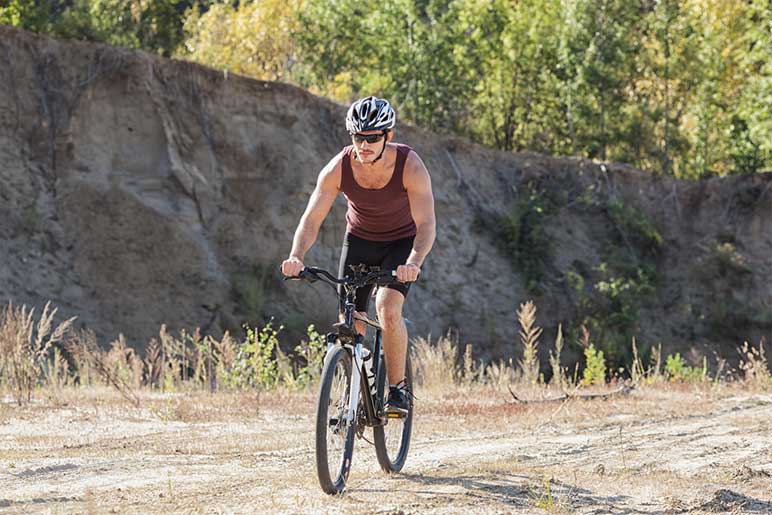
Let’s start, however, with some stats published by Harvard Medical School. This table shows the number of calories that people of three different weights burn in 30 minutes:
Activity | 125 lbs. | 155 lbs. | 185 lbs. |
|---|---|---|---|
Cycling (12–13.9 mph) | 240 | 298 | 355 |
Cycling (14–15.9 mph) | 300 | 372 | 444 |
Cycling (16–19 mph) | 360 | 446 | 533 |
Mountain biking | 255 | 316 | 377 |
As you can see, the number of calories burned by cycling for 30 minutes varies widely by intensity and weight, from 240 calories of easy cycling by a 125-lb. person to 533 calories of intense cycling by a 185-lb. person.
Because this information was published by the Harvard medical school, you can be confident that these are good numbers. Let’s compare them to the numbers from MapMyRide’s calorie burn calculator with the following variables:
Male, Age 30, Height 5’11”, Weight 155 lbs.
Bike Ride, 30 Minutes, 7.5 mi (15 mph)
Calorie Burn: 359
That’s actually right about where you’d expect, based on Harvard’s information.
Of course, this likely assumes that the entire bike ride was flat, that you kept the same level of intensity all the way through, and that your bike wasn’t making the riding any harder for you. What are the chances that all of those are true?
Probably not great. That being said, the fact that these two calculators give similar answers is a great sign.
Let’s try another one to see what happens. We’ll give the Keisan online calculator a shot. For this one, we’ll use this information:
Female, age 29, height 5’5”, weight 125 lbs.
Bicycling, 30 minutes, 12–14 mph
Calorie burn: 249
Again, that’s quite close to the Harvard results. Even making adjustments for gender, age, and height, the numbers are impressively close.
Still Just an Estimate
Even though these numbers are pretty consistent, it’s important to remember that these counts are still only estimates of calorie burn.
As I’ve mentioned a few times, there are a lot of factors that will change the number of calories that you’ve burned, and many of these calculators don’t take them into account.
Your fitness level is a great example. You might be able to ride at 17 mph comfortably, while I struggle to make 16 mph. My heart rate will be higher, and I’ll be working harder, so there’s a good chance I’ll be burning more calories.
But there isn’t a good way to include that information in your calorie burn estimate (unless you’re using a heart rate monitor, but as we’ve seen, fitness devices aren’t great at estimating calorie burn, either).
So remember that these values are only estimates. This can make it difficult to balance calories consumed and used if you’re trying to be exact, but unfortunately, there’s not much to be done about it.
Cycling vs. other activities for burning calories
So, now that we know that cycling is a great calorie burner, what about other exercises?
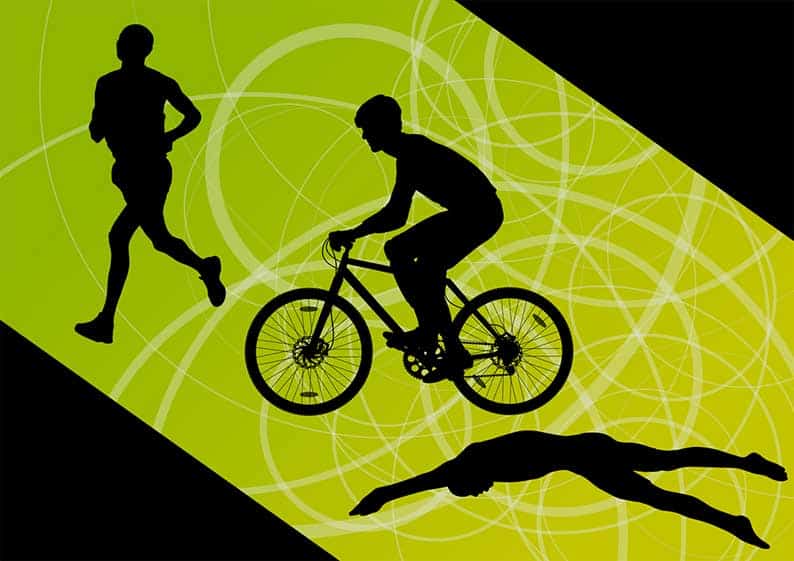
Is cycling the best exercise for torching calories and losing weight?
Let’s take a look at some other aerobic activities from the Harvard data-set:
Activity | 125 lbs | 155 lbs | 185 lbs |
|---|---|---|---|
Weight lifting: general | 90 | 112 | 133 |
Rowing,stationary,moderate | 210 | 260 | 311 |
Walking: 4 mph | 135 | 167 | 200 |
Swimming: general | 180 | 223 | 266 |
Swimming, crawl | 330 | 409 | 488 |
Running: 6 mph | 300 | 372 | 444 |
Running: 6.7 mph | 330 | 409 | 488 |
Stair step machine: general | 180 | 223 | 266 |
Aerobics, step, low-impact | 210 | 260 | 311 |
Aerobics, step, high-impact | 300 | 372 | 444 |
Stretching, Hatha yoga | 120 | 149 | 178 |
As you can see, these activities fall on both sides of cycling when it comes to burning calories. Some, like running at 6.7 mph, burn more than low- and moderate-intensity cycling. Most others falls below cycling and moderate and high intensities.
It’s worth noting, however, that running at high intensities slightly edges out cycling until you get to around 20 mph on average.
Is Cycling the Best Calorie-Burning Activity?
On the surface, it looks like cycling is pretty much the best calorie-burning exercise you can get. And, to a certain point, that’s true.
It’s definitely up there, especially once you build up enough fitness to start pedaling at higher speeds and for longer times.
The fact that it’s low-impact and doesn’t take as much of a toll on your body as some other exercises is a big bonus, too. And if you’re only concerned about calories, that might be the end of the discussion.
But there are a few other things to keep in mind, too.
For example,
Cycling is mostly non-weight-bearing, so it won’t have the bone-related benefits that you’ll get from running or weightlifting. It also doesn’t exercise your upper body very much, so you’ll be developing leg strength without doing much for your arms, chest, or back.
Cycling has a lot of health benefits, especially when it comes to calorie-burning, but it should be balanced with other types of exercise, especially if you’re trying to improve your health beyond simple weight loss.
If you’re trying to figure out how to burn the most calories, one of the things you can do is consult one of the online calorie burn calculators. Enter the height, weight, and age, then use it to get an estimate of the number of calories you’ll burn during the exercise you’re considering.
How to Burn More Calories with Cycling
If you’re reading this article, you’re almost certainly looking to burn more calories, and probably for weight loss.
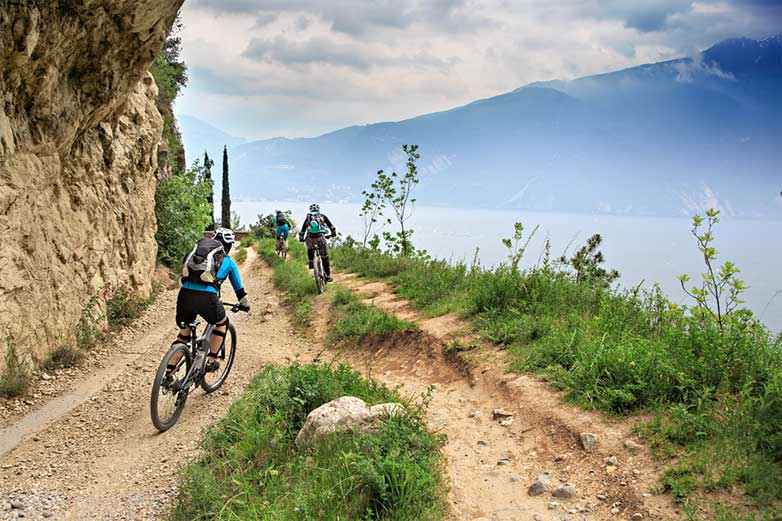
So let’s talk about how you can take cycling—already a great calorie-burning exercise—and turn it into an even better weight loss activity.
Here are four strategies you can use:
Ride More Hills
I can already hear the collective groan in response to this advice. Yes, riding hills sucks. It’s really hard, it can be frustrating, and it hurts. But that’s exactly why it’s so great for burning more calories on the bike.
As I mentioned previously, riding uphill can burn several times more calories than riding on the flats. So how can you take advantage of this to help your weight loss efforts?
You could do hill repeats, but unless you’re training for a competition, that’s not going to appeal to many people. What you can do instead is find hillier routes near where you live. If your normal route is flat, take a detour that takes you over a few hills. When that gets easier, find more hills. Just keep finding more and you’ll get stronger.
You might be asking about the downhills and how that affects your calorie burn. That’s a good question.
In short, don’t worry about it. You burn so many more calories going uphill that it doesn’t matter very much.
However, if you want to maximize your gains, keep pedaling downhill. It’ll keep your heart rate up, and will get you to the flats or the bottom of your next uphill even faster.
Intervals
For the ultimate in calorie-burning, you need intervals. High-intensity interval training (HIIT) is, hands-down, the best way to torch a ton of calories.
The idea is simple: alternate very high-intensity cycling with lower-intensity stretches to catch your breath. That’s all there is to it.
Many people find complicated formulas, or use their heart rate or other metrics, but the important thing is that you alternate high- and low-intensity cycling.
Numerous studies have shown that interval training is a great way to improve your cardiovascular fitness. And it has lots of other benefits, too, like increased insulin resistance, improved fat loss, increased calorie burning throughout the day, and general improvements in both aerobic and anaerobic fitness.
So what kind of intervals should you do? In the beginning, you’ll want to start slow.
Do thirty seconds of high-intensity cycling separated by two minutes of rest. When that starts to get easier, lower your rest to 60 seconds. Once you can comfortably do the 30–60 interval for 15 or 20 minutes, you can start varying your interval workouts.
Bicycling has a lot of awesome interval workouts you can try, including the killer Flying 40s, which see you cycling hard for 40 seconds, then cooling down for 20, for ten minutes.
You can do up to four sets of them.
Trust me, they’re brutal. You can do longer intervals, too, like cycling at higher intensity for 30 minutes with a 10-minute low-intensity cool down in between.
If you absolutely hate intervals, you can always go for a hilly ride, as you get much the same effect.
Hit the Dirt—or the Road
If you do most of your riding on the road or bike path, trying mountain biking to torch more calories. You’ll use different muscles, engage in different aerobic patterns, and have to really work hard. If you don’t have a mountain bike, try renting one for a day or borrowing one from a friend. Read about different types of bikes here.
I think you’ll be surprised at just how different (and how difficult) it is!
The opposite also applies: if you usually do your riding on the trail, hit the road for a different kind of challenge.
You might think that the lack of skills-based challenges would make road riding a lot easier, but the aerobic demands are different (and very difficult).
Especially if you get into intervals.
Try a Triathlon
If you really want to up the calories you burn, sign up for a triathlon. It’s not all cycling—it’ll require a lot of time spent running and in the pool—but the fact that you’re good on your bike will be a big advantage. And signing up for the race will definitely motivate you to cross-train.
Remember how doing the same type of exercise for a long time reduces your calorie burn? This is the solution.
It doesn’t need to be a super long triathlon, and you don’t have to be competitive about it. Just set a goal to complete a sprint triathlon (this is the shortest distance) within the next year.
Sign up for one, and you’ll be running, swimming, and torching calories in no time.
How to Turn Calories Burned into Weight Loss
Most people who are concerned about burning calories are interested in losing weight. And although weight loss is itself a very complex topic, we’ll talk here a bit about what you need to know beyond just how many calories you’re burning.
You have a really good idea of how to burn a lot of calories. Now it’s time to take a few more steps to turn that calorie burn into weight loss.
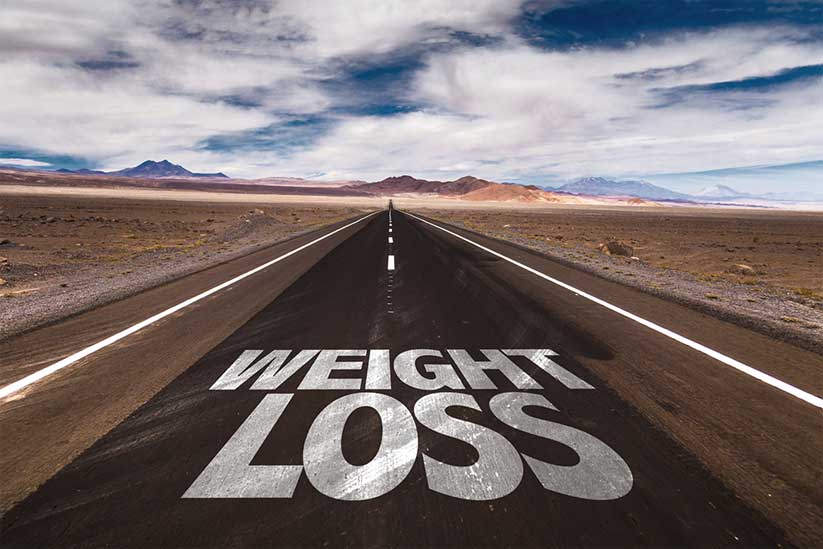
Understand Your Resting Metabolic Rate
Your body is always burning calories, even when you’re sleeping. The number of calories that you burn at rest is called your resting metabolic rate.
Getting an estimate of your resting metabolic rate will help you figure out how many calories you need to burn to lose weight.
The RMR Calculator at Bodybuilding.com is a great place to get an estimate of your resting metabolic rate.
Once you’ve figured out this number, you can add your exercise to it to see how many calories you’re burning in a day.
Consume fewer calories than that, and you’ll lose weight. It’s as simple as that.
Set a Calorie Deficit Goal
If you burn 3,000 calories in a day and consume 2,500, that’s a deficit of 500 calories per day. So how much should you aim for?
Most weight-loss programs suggest a calorie deficit of 500 calories per day. That adds up to about a pound of weight loss each week (though this, again, is an oversimplification).
You might be able to stretch it beyond 500 on some days, and that will help speed your weight loss.
Of course, if you overeat on the weekends or splurge on a dessert, that’s going to slow your progress.
It’s all about establishing a regular deficit and sticking with it. Don’t worry when you don’t make your goal for the day.
you can use bike trainer if you can't able to use bike outside.
Weight loss is about steady loss over long periods of time, not dropping lots of pounds in a few days.
Measure Calorie Intake
This is the part of weight loss that, frankly, sucks. Tracking the number of calories you eat is no fun, and it can be a big hassle. But there are a few ways you can make it better.
First of all, realize that you don’t need to count calories every day. This is something that makes a lot of people get off the dieting train, but it doesn’t need to derail your plans.
Instead, count your calories twice a week. Once on a weekday, and once on a weekend day. This will help you discover how many calories you’re eating and teach you to better estimate how much food you need.
Your weight loss won’t progress as quickly as if you were counting calories every day, but it takes less mental effort. Most people find it much easier.
Use the Right Tools
When you’re counting calories, use a calorie-tracking app on your phone. MyFitnessPal is a great place to start. There are lots of foods already in the app, so all you have to do is search for the one you ate.
You’ll still have to measure all of your food, but this too will give you a better idea of how much you need and how much you’re eating.
Most calorie-counting apps do a lot more than just keep track of how much you’re eating. They’ll also give you calorie-burn estimates, tell you how many calories you should be eating to meet your weight-loss goal, and even track your workouts with GPS.
Here are a few of the best weight-loss apps to help you on your cycling weight-loss journey:
Whichever app you choose, make sure it’s one that you like. The easier it is to use and the more you like using it, the more likely you’ll be to track your food and exercise.
A Warning about Tracking Your Weight
If you’re trying to lose weight, you’ll probably step on the scale to see how you’re doing. And that’s not necessarily a bad thing—but there are a few things you need to keep in mind.
First, don’t check your weight every day.
Yes, it’s exciting to see small, regular gains. But your weight fluctuates a lot over the course of a day, and between days (much of this is due to differences in water retention). And it’s easy to get discouraged by those fluctuations.
Jillian Michaels, one of the most-respected trainers in pop culture, recommends weighing yourself once a week. You could even go a bit longer than that, and weigh yourself once every two weeks.
You’ll still get to see the progression of your weight loss, but you’re less likely to get fixated on your weight or discouraged by temporary fluctuations.
Second, remember that weight isn’t everything. You’re trying to lose weight to improve your body and improve your health, and those aren’t inextricably tied to weight loss. You’ll still building muscle as you ride more, for example—and muscle weighs more than fat. So as you get stronger, you actually might see some small weight gains. And that’s not a bad thing.
Keep a close eye on the changes happening to your body, and use that as a guide to the effectiveness of your exercise. You know your body best, and you can judge whether your cycling is having the desired effect.
Also, pay attention to your increases in fitness, as they’re closely tied to increases in your health. As you’re able to exercise longer, other indicators of your health, like your blood pressure and body composition, are likely changing as well. Weight loss is more about fitness and health than it is about the number of pounds you lose.
Don’t forget that.
Burning Calories and Losing Weight on the Bike
Enter your Like anything else, the most important thing you can do when it comes to burning calories and losing weight with cycling is to just get started. Don’t worry about calorie counts, specific markers of fitness, or anything else—just get on your bike and start riding.
The more comfortable you get with cycling, the more you’ll do it. And the fitter you become, the more you’ll be able to ride. The more you ride, the more you’ll love it. It’s a big cycle (no pun intended), and it’ll make a big difference in your life.
And remember to not get too fixated on calorie counts and weekly weigh-ins. Yes, they’re important, but fitness—and life—is more than a series of small changes in nearly arbitrary numbers.

